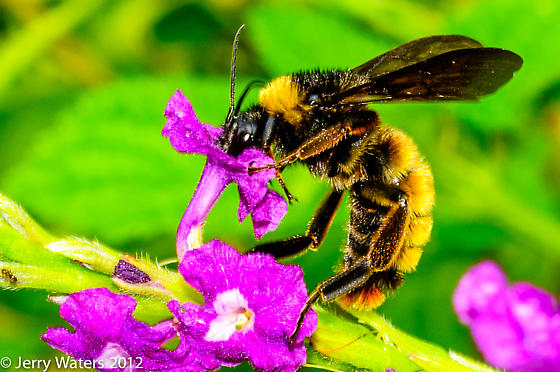 Species Decline and Conservation
Species Decline and Conservation
In many parts of the United States, the Bombus Pensylvanicus
was considered the most common bumble bee until 1990 (Nature
Serve 2012). Since then there has been a great decline in the
numbers of not only the Bombus pensylvanicus, but also
many other North American bumble bee species (Cameron et al.
2011). The current Rounded Global Status rank for B.
pensylvanicus is G3—indicating that the species is
vulnerable (Nature Serve 2012). There is no evidence to suggest
whether the species will continue to decline or stabilize in the
coming decades (Nature Serve 2012). The American Bumble Bee is
an important pollinator so the decline of this species can have
other ecological impacts (Lozier and Cameron 2009). While there
is speculation as to the cause of the decline of Bombus
pensylvanicus, there is not yet any conclusive evidence
explaining the downward trend (Nature Serve 2012).
There are however, a myriad of possible causes. One of the
most probable explanations has to do with landscape modification;
many natural B. pensylvanicus habitats which previously
hosted the plants pollinated by this species have been destroyed to
allow the mass production of crops such as corn and soybeans (Lozier
and Cameron 2009). It is also suggested that B. pensylvanicus’
aboveground nests are more vulnerable to destruction than
underground nests of other Bombus species (Lozier and Cameron
2009). A threat to the Bombus pensylvanicus, but known for
the decline of bumble bee populations in Europe is the pathogen
Nosema bombi (Cameron et al. 2011). Though there is no
conclusive evidence linking this parasite to the decline of Bumble
Bees in the United States, it is a possible explanation because the
decline of North American Bumble Bees mirrors that of the decline in
Europe starting in the 1950’s (Cameron et al. 2011). Another
possible explanation for the decline is the use of pesticides on
commercial crops; these pesticides—meant to control crop-destroying
pests NOT pollinators like Bombus pensylvanicus—have been
found in concentrations lethal to the American Bumble Bee on
guttation drops on grass and other plants (Encyclopedia of Life).
The extinction of pollinator species such as the American
Bumble Bee would be devastating to ecosystems, but we would also be
losing a piece of our history. So what can be done to preserve the
Bombus pensylvanicus? In the discussion of their analysis of
historical Bumble Bee DNA, Lozier and Cameron suggest planting
wildflower seeds in the areas surrounding commercial crops, in lieu
of mowing these areas down (Lozier and Cameron 2009). They say that
this could increase not only pollination opportunities and habitat
resources, but also increase gene flow between populations of
Bombus species.